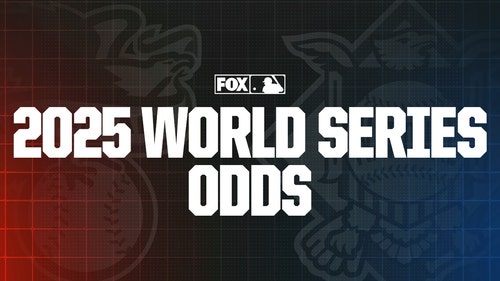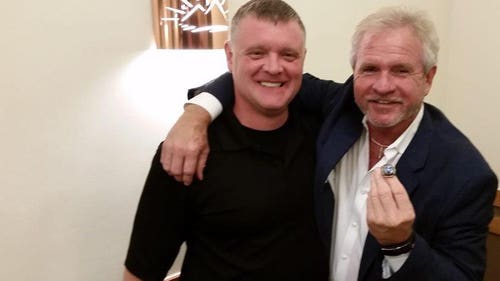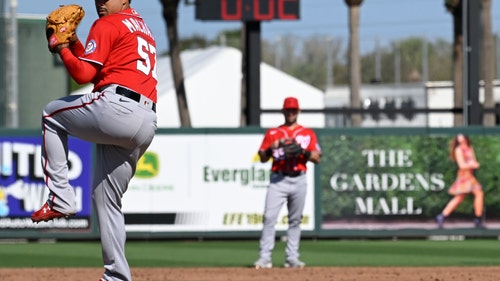
MLB Draft 2023: Six biggest takeaways from Day 1
SEATTLE — The first 70 picks of the 2023 MLB Draft are in the books, with the league’s annual infusion of amateur talent into the affiliated ranks commencing at Lumen Field in Seattle across from T-Mobile Park. It’s been plenty fun preparing for the draft over the past few months, but you never know what’s actually going to happen once the picks start rolling in.
Here are my six biggest takeaways from Day 1.
1. The first five picks were exactly as expected … sort of
Thirty-six years after being selected first overall in the 1987 MLB Draft, Hall of Famer and local icon Ken Griffey Jr. strode to the podium to a raucous applause from the Seattle crowd to announce the Pittsburgh Pirates' selection with the top pick in 2023.
For months, it had become clear that an elite tier of five players stood out from the rest of the class: LSU right-handed pitcher Paul Skenes, LSU outfielder Dylan Crews, Florida outfielder Wyatt Langford, and two high school outfielders in Max Clark from Indiana and Walker Jenkins from North Carolina. What was not clear was the exact sequence these five players would be selected, but it seemed like the three collegians had emerged the most likely first three names off the board in some order.
Ultimately, Skenes won the day as the best pitching prospect in recent memory and too overwhelming a talent for Pittsburgh to pass up, regardless of the risk inherent with any arm. The Washington Nationals happily scooped up Crews at No. 2, making for the unusual instance in draft history where getting a player at second overall almost felt like a steal. Geaux Tigers.
That’s when things got weird.
Strong assumptions within the industry regarding the Detroit Tigers' preference for a college bat turned out to be wrong, as they opted for Clark over Langford. It’s likely the Tigers saved more bonus pool money with Clark than they would have with Langford, but this was still a potentially bold decision to roll with the prep bat over a player in Langford who was smashing jaw-dropping homers in the College World Series just a few weeks ago.
We all thought the Texas Rangers would be choosing between Clark and Jenkins, but instead they were left with the easy selection of Langford at No. 4. Rumors regarding the Minnesota Twins' potential interest in targeting a college player in the first round also turned out to be wrong, as they decided to keep it simple and roll with Jenkins to round out the top five. I think that was the right call, especially considering their fortunate circumstance of even picking that high after getting the best luck in the inaugural draft lottery of any team, jumping up to No. 5 despite having the 13th-best odds to get a top pick.
All in all, it was exactly what we all expected for months and, in some ways, not quite what we were prepared for. Such is the beauty and chaos of the baseball draft.
[RELATED: MLB Draft 2023: What to know about every first-round pick]
2. The Giants had the most interesting draft of the night
Last year, the Giants selected Reggie Crawford from the University of Connecticut and announced him as a two-way player, immediately putting his career under a unique spotlight as the rare prospect being given the opportunity to hit and pitch in the pro ranks. Sure enough, it was San Francisco who took the plunge again this year for the top two-way talent in the draft in Bryce Eldridge, a 6-foot-7 prep phenom from Virginia with thunderous raw power and enticing ingredients on the mound.
Eldridge’s development will be even more fascinating to monitor as he enters pro ball straight from the high school ranks, unlike Crawford who had demonstrated his abilities on both sides of the ball at the Division-I level for multiple years.
To put it simply, this doesn’t feel like a coincidence. Any team would now let Shohei Ohtani play both ways for them because he’s a known commodity of excellence at the highest level; I don’t believe all 30 teams have the patience to develop two-way stars from the amateur ranks all the way up the grueling minor-league ladder. These two picks alone are enough proof that the Giants are a team more than willing to give it a shot, which is very cool.
Eldridge offers enough intrigue on his own atop any draft class, but the Giants’ next two selections at Nos. 52 and 69 further underscored what I found to be the most interesting crop of picks of any team on Day 1. Walker Martin, a high school shortstop from Colorado, was rumored to be in play for the Giants with their first pick at No. 16 but instead fell all the way to their second round selection. It’s not entirely uncommon to see high school players go in strange sequences over the first day of the draft, but Martin falling this far made me think there had to be something more to the story, whether it be medical-related or just that his age — he turned 19 in February — scared off way more teams than expected.
Finally, the Giants rounded out their night with lefty Joe Whitman, whose draft stock had seemingly been surging in recent weeks as maybe the best available college southpaw. He ended up being the third one off the board behind Wake Forest’s Sean Sullivan and Clemson’s Caden Grice, but I wouldn’t be surprised if we fast-forward a year and see this pick being a steal — just like Martin. Nice job, Giants.
3. The Marlins had my favorite draft of the night
I consistently pondered throughout the spring and the mock-draft process whether Miami would use the 10th overall pick on a hitter to add some much-needed offensive upside to its farm system, or if the organization would double-down on what it is already good at and take another pitcher to develop into an impact big-league arm. Well, the Marlins answered that question rather boldly with their first two selections, landing arguably the two best high school pitchers in the entire draft, with right-hander Noble Meyer at No. 10 followed by lefty Thomas White at No. 35. Prep pitchers are always terrifyingly risky, but you certainly won’t catch me betting against the Fightin’ Fish to get the most out of these two youngsters if they can stay healthy. That’s a dynamite duo of teenage arms to add to a system that just introduced us to a 20-year-old superstar in Eury Pérez.
But what made Miami’s draft my favorite one of the evening was balancing out those top two selections with Ole Miss outfielder Kemp Alderman at No. 47. Alderman was one of my favorite college hitters available, an absolute thumper with outrageous raw power that is some of the best in the entire class. Still just 20 years old until August, he’s young for the class as well, and has performed in the gauntlet that is the SEC for multiple seasons. I was confident he’d be a great value pick for some lucky team toward the end of Day 1, but it was extra cool to see him complement a pair of prep pitchers in the Marlins’ class.
For the record: Arizona, Milwaukee and Tampa Bay were three other draft classes that stood out to me thus far among teams that weren’t selecting at the very top, but there are plenty more picks to be made over the next few days. Other teams have ample time to impress!
4. Brandon Sproat was the funniest pick of the night
This has nothing to do with how good Sproat is as a pitcher. The right-hander from the University of Florida is one of the draft’s hardest throwers and showed flashes of brilliance in college baseball’s toughest conference over several seasons. But for the Mets — the team that failed to sign Sproat a year ago after taking him 90th overall — to call him back this time around and say, hey, let’s try this again at No. 56? That’s just hilarious.
I am beyond curious what Sproat’s signing bonus ends up being, especially considering the Mets’ first selection of the night, highly touted high school shortstop Colin Houck at No. 32, could cost considerably more than the roughly $2.6 million slot associated with that pick. How much do they really have to still give Sproat from an overall bonus pool of $8.4 million that is already one of the smallest in the draft? The saga gets better: Sproat has Scott Boras as his advisor. Not sure if you’ve noticed, but he usually gets his clients a good chunk of change.
5. The Dodgers are up to something, but it’s hard to doubt them
The sequence of the first round had some surprises, but the Dodgers gave us our first real stunner of the evening with the selection of Kendall George at No. 36. George is a high school outfielder from Texas who has a case for being the fastest runner in the entire class. His interesting offensive skill set also features solid bat-to-ball talent yet exceptionally little raw power to speak of. This does not seem like the kind of player the Dodgers would normally target, and that makes the pick all the more intriguing — on top of the fact that most in the industry considered George a late second- or third-round talent.
That makes me think they got George at a comfortably under-slot deal, only they followed that selection with a college bat in Jake Gelof at No. 60, which is just about where he was expected to go and thus probably precipitating a bonus in line with the slot recommendation. To quote Brian Windhorst: What’s going on in Los Angeles? Do they have something up their sleeves for pick No. 95 with an over-slot high schooler that we would never expect to fall that far? We’ll see!
6. What happened to Jack Hurley?
Speaking of the Dodgers, one player I thought would be a nice fit for them with their first pick was Virginia Tech outfielder Jack Hurley. He's been one of the most productive hitters in the ACC over the last two seasons and seemed like a lock to go somewhere in the 20-40 range. Instead, he remains unselected heading into Day 2.
It’s not unusual to see highly-ranked high schoolers fall due to signing bonus demands related to college commitments and whatnot — we'll see if this becomes more commonplace in the NIL era — but Hurley’s name still being on the board feels especially odd with him being a fairly proven college bat. I’d still expect him to be one of the first guys to hear his name called on Day 2, and that team could end up with quite the player for a third-rounder. Stay tuned.
Jordan Shusterman is half of @CespedesBBQ and a baseball writer for FOX Sports. He has covered baseball for his entire adult life, most notably for MLB.com, DAZN and The Ringer. He's a Mariners fan living in the Eastern Time Zone, which means he loves a good 10 p.m. first pitch. You can follow him on Twitter @j_shusterman_.










